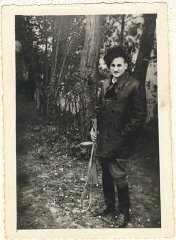<< Previous | Displaying results 2101-2125 of 2611 for "" | Next >>
-
German documents collected by war crimes investigators
PhotoUS Army staffers organizing stacks of German documents collected by war crimes investigators as evidence for the International Military Tribunal.

-
Opening statement at the International Military Tribunal
PhotoChief US Counsel Justice Robert Jackson delivers the prosecution's opening statement at the International Military Tribunal. Nuremberg, Germany, November 21, 1945.
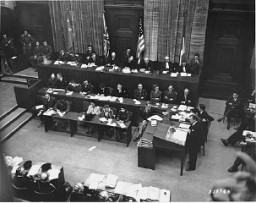
-
The accused and their defense attorneys at Nuremberg
PhotoThe accused and their defense attorneys in the courtroom during the International Military Tribunal. Nuremberg, Germany.
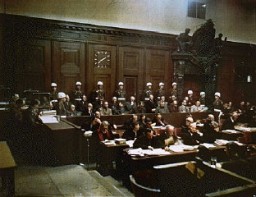
-
Translators at the Nuremberg trial
PhotoEnglish, French, Russian, and German were official languages of the Nuremberg trials. Translators provided simultaneous translations of the proceedings. Here, they route translations through a switchboard to participants in the trial. Nuremberg, Germany, November 1945.

-
Amalie Petranka (later Salsitz)
PhotoAmalie Petranka (later Salsitz) at 22 years of age. She gave this photo to Norman Salsitz shortly after they met. Photograph taken in Stanislawow, Poland, on October 10, 1939.
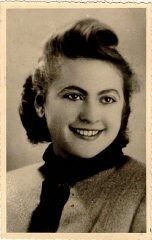
-
Norman Salsitz under an assumed identity
PhotoNorman Salsitz while under the assumed identity Tadeusz Zaleski. Legnica, Poland, 1945.
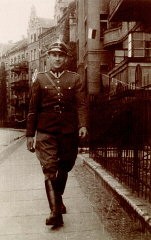
-
Norman Salsitz and Amalie Petranka shortly after they met
PhotoNorman Salsitz and Amalie Petranka shortly after they met (under their assumed identities of, respectively, Felicja Milaszewska and Tadeusz Zaleski). Krakow, Poland, March 15, 1945. With the end of World War II and collapse of the Nazi regime, survivors of the Holocaust faced the daunting task of rebuilding their lives. With little in the way of financial resources and few, if any, surviving family members, most eventually emigrated from Europe to start their lives again. Between 1945 and 1952, more than…

-
Amalie and Norman Salsitz, Brooklyn, New York, 1949
Photo1949 photograph of Amalie and Norman Salsitz in Brooklyn, New York, two years after they came to the United States. With the end of World War II and collapse of the Nazi regime, survivors of the Holocaust faced the daunting task of rebuilding their lives. With little in the way of financial resources and few, if any, surviving family members, most eventually emigrated from Europe to start their lives again. Between 1945 and 1952, more than 80,000 Holocaust survivors immigrated to the United…

-
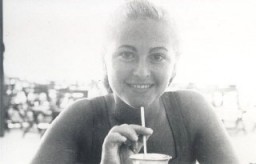
-
Norman Salsitz's daughter
PhotoNorman's daughter, Esther, at age one. April 1957. With the end of World War II and collapse of the Nazi regime, survivors of the Holocaust faced the daunting task of rebuilding their lives. With little in the way of financial resources and few, if any, surviving family members, most eventually emigrated from Europe to start their lives again. Between 1945 and 1952, more than 80,000 Holocaust survivors immigrated to the United States. Norman was one of them.
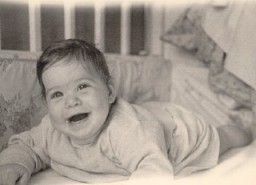
-
Norman Salsitz's wife and daughter
PhotoNorman's daughter, Esther, at three weeks of age, with her mother, Amalie. September 1956. With the end of World War II and collapse of the Nazi regime, survivors of the Holocaust faced the daunting task of rebuilding their lives. With little in the way of financial resources and few, if any, surviving family members, most eventually emigrated from Europe to start their lives again. Between 1945 and 1952, more than 80,000 Holocaust survivors immigrated to the United States. Norman was one of them.
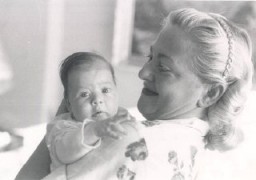
-
Norman Salsitz in the United States
PhotoNorman (with camera) in the United States. August 1948. With the end of World War II and collapse of the Nazi regime, survivors of the Holocaust faced the daunting task of rebuilding their lives. With little in the way of financial resources and few, if any, surviving family members, most eventually emigrated from Europe to start their lives again. Between 1945 and 1952, more than 80,000 Holocaust survivors immigrated to the United States. Norman was one of them.
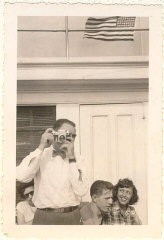
-
Amalie and Norman Salsitz go to Israel
PhotoAmalie and Norman Salsitz go to Israel to visit family members. Lod (Lydda), Israel, February 9, 1949. With the end of World War II and collapse of the Nazi regime, survivors of the Holocaust faced the daunting task of rebuilding their lives. With little in the way of financial resources and few, if any, surviving family members, most eventually emigrated from Europe to start their lives again. Between 1945 and 1952, more than 80,000 Holocaust survivors immigrated to the United States. Norman was one of…
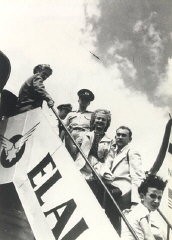
-
Amalie with her grandmother and sister in Tel Aviv
PhotoAmalie (left) with her grandmother and sister Pepka in Tel Aviv, Israel, 1949.
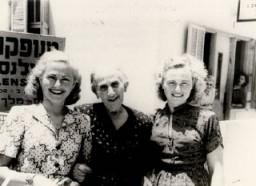
-
Photograph taken at Esther Salsitz's marriage
PhotoPhotograph taken at the marriage of Esther Salsitz and her fiance. Esther's parents, Norman and Amalie, stand at left and right (respectively). June 19, 1977. With the end of World War II and collapse of the Nazi regime, survivors of the Holocaust faced the daunting task of rebuilding their lives. With little in the way of financial resources and few, if any, surviving family members, most eventually emigrated from Europe to start their lives again. Between 1945 and 1952, more than 80,000 Holocaust…

-
Norman and Amalie Salsitz with their first grandchild
PhotoNorman and Amalie Salsitz with their first grandchild, Dustin. March 11, 1983. With the end of World War II and collapse of the Nazi regime, survivors of the Holocaust faced the daunting task of rebuilding their lives. With little in the way of financial resources and few, if any, surviving family members, most eventually emigrated from Europe to start their lives again. Between 1945 and 1952, more than 80,000 Holocaust survivors immigrated to the United States. Norman was one of them.
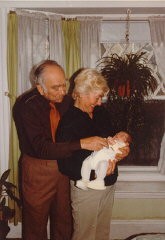
-
Norman Salsitz's grandchildren
PhotoNorman's grandchildren, Dustin, Aaron, and Michael. September 30, 1993. With the end of World War II and collapse of the Nazi regime, survivors of the Holocaust faced the daunting task of rebuilding their lives. With little in the way of financial resources and few, if any, surviving family members, most eventually emigrated from Europe to start their lives again. Between 1945 and 1952, more than 80,000 Holocaust survivors immigrated to the United States. Norman was one of them.
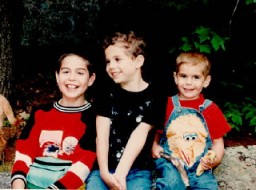
-
Amalie and Norman Salsitz with a copy of their book
PhotoJune 6, 1991, photograph showing Amalie and Norman Salsitz with a copy of their book, Against All Odds. With the end of World War II and collapse of the Nazi regime, survivors of the Holocaust faced the daunting task of rebuilding their lives. With little in the way of financial resources and few, if any, surviving family members, most eventually emigrated from Europe to start their lives again. Between 1945 and 1952, more than 80,000 Holocaust survivors immigrated to the United States. Norman was one of…
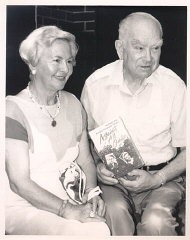
-
Norman Salsitz's grandchildren in 1997
PhotoNorman's grandchildren, Michael, Dustin, and Aaron in 1997. With the end of World War II and collapse of the Nazi regime, survivors of the Holocaust faced the daunting task of rebuilding their lives. With little in the way of financial resources and few, if any, surviving family members, most eventually emigrated from Europe to start their lives again. Between 1945 and 1952, more than 80,000 Holocaust survivors immigrated to the United States. Norman was one of them.
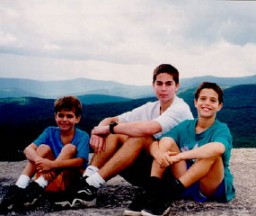
-
Norman Salsitz holds a photograph of himself and Amalie
PhotoNorman Salsitz holds a photograph of himself and Amalie from 1945. 2004. With the end of World War II and collapse of the Nazi regime, survivors of the Holocaust faced the daunting task of rebuilding their lives. With little in the way of financial resources and few, if any, surviving family members, most eventually emigrated from Europe to start their lives again. Between 1945 and 1952, more than 80,000 Holocaust survivors immigrated to the United States. Norman was one of them.
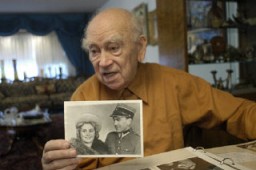
-
Norman Salsitz holds a photograph of his wife and daughter
PhotoNorman Salsitz holds a photograph of his wife, Amalie, and daughter, Esther. 2004. With the end of World War II and collapse of the Nazi regime, survivors of the Holocaust faced the daunting task of rebuilding their lives. With little in the way of financial resources and few, if any, surviving family members, most eventually emigrated from Europe to start their lives again. Between 1945 and 1952, more than 80,000 Holocaust survivors immigrated to the United States. Norman was one of them.
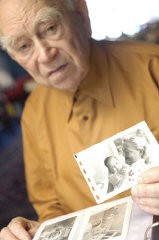
-
2004 portrait of Norman Salsitz
PhotoBorn Naftali Saleschutz, Norman was the youngest of nine children in a devout Hasidic Jewish family. They lived in Kolbuszowa, Poland. In the Hasidic tradition, he wore a long black coat and shoulder-length earlocks. He first faced antisemitism in the second grade when his teacher cut one earlock off each Jewish boy.
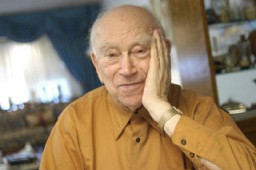
-
Norman Salsitz looking through his photographs
PhotoNorman Salsitz looks through his prewar family photographs. 2004. With the end of World War II and collapse of the Nazi regime, survivors of the Holocaust faced the daunting task of rebuilding their lives. With little in the way of financial resources and few, if any, surviving family members, most eventually emigrated from Europe to start their lives again. Between 1945 and 1952, more than 80,000 Holocaust survivors immigrated to the United States. Norman was one of them.

-
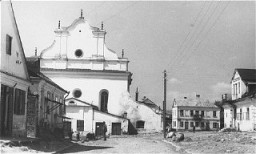
-
Aron Derman while he was with Polish partisans in 1944.
PhotoAron Derman while he was with Polish partisans in 1944. In this photograph, Aron wears a fur hat that he made and boots that he finished himself (he found them in the ghetto, unfinished, and sewed them up). Lisa Nussbaum was also a member of the partisans. Aron recounted that for a short while, Lisa was in charge of 200 women. Photograph taken in 1944, in a partisan base in the Naroch forest.
